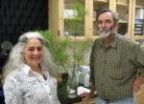(Press-News.org) (Santa Barbara, Calif.) –– Simply by eating the leaves of an invasive tree that soaks up river water, an Asian beetle may help to slow down water loss in the Southwestern United States.
Two scientists from UC Santa Barbara, working with colleagues from the U.S. Geological Survey and the U.S. Department of Agriculture, have published the first substantive data showing water savings that can result from using Asian beetles for the biological control of tamarisk, an invasive tree of western rivers. The study is now published online and in print in the journal Oecologia.
"Widespread growth of this tree is a critical issue in arid regions facing greater social water demands," said Carla D'Antonio, Schuyler Professor of Environmental Studies at UCSB. "It happens at a time when water supplies may be reduced as a consequence of climate change. Additionally, society is increasingly concerned about wildlife species that depend on these wetland ecosystems."
Tamarisk, also known as saltcedar, is an invasive tree or shrub from Eurasia that occupies over one million acres of riverside habitat in western North America. It displaces native riparian woodlands, reduces habitat quality for wildlife, exacerbates erosion and sedimentation problems, and is flammable, therefore a wildfire hazard. The tree was introduced into North America over 100 years ago, and has overtaken many Western river systems.
The study was conducted in the Great Basin of Nevada as part of a USDA Agricultural Research Service program to develop new methods for invasive plant management. During the first year of large-scale tamarisk defoliation by the tamarisk leaf beetle (Diorhabda carinulata), approximately 2,500 acre-feet of water remained in the ground rather than being lost to the atmosphere. This was in the Humboldt River Basin of northern Nevada in an area of approximately 4,500 acres where tamarisk vegetation dominates.
"This is roughly the same amount of water that would be used to irrigate 1,000 agricultural acres in a year," said Tom Dudley, associate research biologist at UCSB, who cited Pacific Institute figures. "At a value of $185 per acre-foot, or almost a half million dollars, this amount of water could provide for the annual water needs of 5,000 to 10,000 households. It suggests that the biocontrol of weedy tamarisk across the Western U.S. could play an important role in conserving limited water resources."
The researchers pointed out that in warmer desert regions of the U.S. southwest, where water demand by vegetation and by humans is higher, water savings via tamarisk control could be even more important. In some regions the plants that come back following tamarisk control, particularly wetland plants like cottonwoods and willows, also tend to use a large amount of water but they do not get as dense nor cover as much area of the river corridor as tamarisk. So water savings will still accrue, as will benefits to wildlife that depend on these native riparian plants for habitat.
First author Robert Pattison, now an analyst with the U.S. Forest Service PNW Research Station, worked from March through December for two years at field sites along the Humboldt and Walker rivers in western Nevada. Both sites have dense infestations of tamarisk and daily high temperatures of about 100 degrees in mid-summer.
Pattison gave a glimpse of the fieldwork involved in the project. "In addition to the heat and dust, we contended with occasional rattlesnakes. And there were cows and rabbits that developed a taste for the cables on our equipment," said Pattison. "Aside from these challenges, the work was very rewarding –– in part because of interactions with ranchers and other land owners who granted us access to their lands. And it was rewarding because of the dramatic effect the tamarisk leaf beetle had on tamarisk trees. Entire stands were defoliated within a few years of release."
INFORMATION:
Scientists study control of invasive tree in western US
2011-03-03
ELSE PRESS RELEASES FROM THIS DATE:
Scripps oceanography researchers discover arctic blooms occurring earlier
2011-03-03
Warming temperatures and melting ice in the Arctic may be behind a progressively earlier bloom of a crucial annual marine event, and the shift could hold consequences for the entire food chain and carbon cycling in the region.
Scientists at Scripps Institution of Oceanography at UC San Diego, along with colleagues in Portugal and Mexico, plotted the yearly spring bloom of phytoplankton—tiny plants at the base of the ocean food chain—in the Arctic Ocean and found the peak timing of the event has been progressing earlier each year for more than a decade. The researchers ...
Arizona Swingers Awarded 1-Year Memberships
2011-03-03
Swinglifestyle is rewarding Arizona swingers with a 1-year paid membership in appreciation for the lifestyle. For a limited time residents in Arizona will benefit with a no frills paid 1-year membership. The membership will include all the benefits of a regular one year account, a value of $69 dollars. New and existing free members will receive full access to all areas of the site including unlimited emails, chat, swingersboard, adult photo access and many more perks. Residents in Arizona are urged to participate in the limited time paid membership immediately.
For local ...
Black holes: a model for superconductors?
2011-03-03
Urbana, Ill.—Black holes are some of the heaviest objects in the universe. Electrons are some of the lightest. Now physicists at the University of Illinois at Urbana-Champaign have shown how charged black holes can be used to model the behavior of interacting electrons in unconventional superconductors.
"The context of this problem is high-temperature superconductivity," said Phillips. "One of the great unsolved problems in physics is the origin of superconductivity (a conducting state with zero resistance) in the copper oxide ceramics discovered in 1986." The results ...
6-month drug regimen cuts HIV risk for breastfeeding infants, NIH study finds
2011-03-03
Giving breastfeeding infants of HIV-infected mothers a daily dose of the antiretroviral drug nevirapine for six months halved the risk of HIV transmission to the infants at age 6 months compared with giving infants the drug daily for six weeks, according to preliminary clinical trial data presented today.
The longer nevirapine regimen achieved a 75 percent reduction in HIV transmission risk through breast milk for the infants of HIV-infected mothers with higher T-cell counts who had not yet begun treatment for HIV.
The study was presented at the 18th Conference on ...
Decline in CP diagnoses in premature infants suggests improvements in perinatal care
2011-03-03
Cincinnati, OH, March 3, 2011 -- Cerebral palsy is a neurodevelopmental condition that affects motor function, more often in children born prematurely. Because cerebral palsy is a result of brain injury received shortly before, during, or soon after birth, the number of infants being diagnosed with the condition is a good indicator of the quality of perinatal and neonatal care. An article soon to be published in the Journal of Pediatrics indicates that the rates of cerebral palsy have declined dramatically in the past 15 years.
Dr. Ingrid van Haastert and colleagues ...
Stigma weighs heavily on obese people, contributing to greater health problems
2011-03-03
WASHINGTON, DC, March 1, 2011 — The discrimination that obese people feel, whether it is poor service at a restaurant or being treated differently in the workplace, may have a direct impact on their physical health, according to new research from Purdue University.
"Obesity is a physiological issue, but when people have negative interactions in their social world—including a sense of being discriminated against—it can make matters worse and contribute to a person's declining physical health," said Markus H. Schafer, the doctoral student in sociology and gerontology who ...
SEO Expert Mike Luchen Has Been Recognized for His Success in Internet Marketing, Social Media and SEO in Westchester County, NY
2011-03-03
Mike Luchen has been recognized for his success in providing solutions to businesses wishing to thrive and grow. Mike has developed the strategies and knowledge required to provide business with the Internet exposure they need reach the level of success they wish quickly and easily.
Mike uses a holistic approach to successful marketing that include the use of SEO SEM online marketing advertising, public relations, social media marketing, Google Maps, Yahoo and local listings. Using the most technologically advanced strategies to generate response to your marketing efforts, ...
Women who miscarry continue to have mental health problems
2011-03-03
The depression and anxiety experienced by many women after a miscarriage can continue for years, even after the birth of a healthy child, according to a study led by University of Rochester Medical Center researchers and published online today by the British Journal of Psychiatry.
"Our study clearly shows that the birth of a healthy baby does not resolve the mental health problems that many women experience after a miscarriage or stillbirth," said Emma Robertson Blackmore, Ph.D., assistant professor of Psychiatry at the Medical Center and the lead researcher. "This finding ...
Sperm quality and counts worsening in Finland
2011-03-03
A new study published in the International Journal of Andrology reveals that semen quality has significantly deteriorated during the last ten years in Finland, a country that previously was a region with high sperm counts. At the same time, the incidence of testis cancer in the Finnish population showed a remarkable increase, following the worrying trends observed in several countries in Europe and the Americas.
Led by Jorma Toppari, MD, PhD, of the University of Turku, researchers examined three cohorts of 19 year old men between the years of 1998 and 2006. The men that ...
New Research from mobileYouth States Brands and Governments Must Co-Create with the World's 1.2 Billion Mobile Youth to Remain Relevant
2011-03-03
Here Come the Mobile Youth: a Generation of Change Agents Under 30
Key findings from the 65 market Mobile Youth Report by consultancy mobileYouth:
- 1.2 billion youth own mobile phones, spending $400 billion annually.
- 60% sleep with their phones. 81% would spend their last $10 on a mobile top-up before food.
- 62% of purchase decisions influenced by peers not traditional paid media.
- Research identified "super-influencers" - fans influencing up to 100 friends in the discovery and education process. Super-influencers were integral in creating change in the Middle ...



